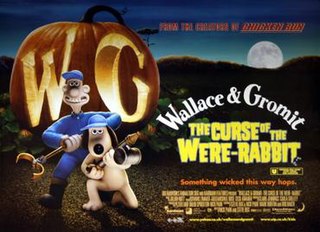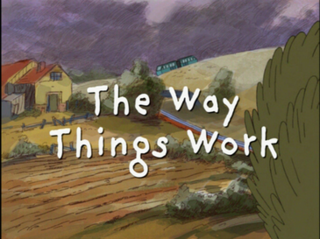Wallace and Gromit is a British stop-motion animated comedy franchise created by Nick Park and produced by Aardman Animations. The main film series consists of four short films and one feature-length film, and has spawned numerous spin-offs and TV adaptations. The series centres on Wallace, a good-natured, eccentric, cheese-loving inventor, and Gromit, his loyal and intelligent anthropomorphic beagle. The first short film, A Grand Day Out, was finished and made public in 1989. Wallace was voiced by actor Peter Sallis until 2010 when he was succeeded by Ben Whitehead. Gromit is largely silent and has no dialogue, communicating through facial expressions and body language.
Aardman Animations Limited is a British animation studio based in Bristol, England. It is known for films and television series made using stop-motion and clay animation techniques, particularly those featuring its plasticine characters from Wallace and Gromit, Shaun the Sheep, Morph, and Angry Kid. After some experimental computer-animated short films during the late 1990s, beginning with Owzat (1997), Aardman entered the computer animation market with Flushed Away (2006). As of February 2020, it had earned $1.1 billion worldwide, with an average $135.6 million per film.

Nicholas Wulstan Park is an English filmmaker and animator who created Wallace and Gromit, Creature Comforts, Chicken Run, Shaun the Sheep, and Early Man. Park has been nominated for an Academy Award a total of six times and won four with Creature Comforts (1989), The Wrong Trousers (1993), A Close Shave (1995) and Wallace & Gromit: The Curse of the Were-Rabbit (2005).

Wallace and Gromit: A Close Shave is a 1995 British stop-motion animated short film co-written and directed by Nick Park and produced by Aardman Animations with Wallace and Gromit Ltd., BBC Bristol and BBC Children's International. It is the third film featuring Wallace and Gromit, following A Grand Day Out (1989) and The Wrong Trousers (1993). A Close Shave won the Academy Award for Best Animated Short Film. A Close Shave saw the first appearance of Shaun, who became the main character of the Shaun the Sheep spin-off series.

A Rube Goldberg machine, named after American cartoonist Rube Goldberg, is a chain reaction–type machine or contraption intentionally designed to perform a simple task in an indirect and (impractically) overly complicated way. Usually, these machines consist of a series of simple unrelated devices; the action of each triggers the initiation of the next, eventually resulting in achieving a stated goal.

The Wrong Trousers is a 1993 British stop-motion animated short film co-written and directed by Nick Park, featuring his characters Wallace and Gromit, and was produced by Aardman Animations in association with Wallace and Gromit Ltd., BBC Bristol, Lionheart Television and BBC Children's International. It is the second film featuring the eccentric inventor Wallace and his dog Gromit, following A Grand Day Out (1989). In the film, a villainous penguin, Feathers McGraw, posing as a lodger, recruits Wallace by using his techno-trousers to steal a diamond from the city museum.

A Grand Day Out with Wallace and Gromit, later marketed as A Grand Day Out, is a 1989 British stop-motion animated short film starring Wallace and Gromit. It was directed, animated and co-written by Nick Park at the National Film and Television School in Beaconsfield and Aardman Animations in Bristol.

Peter John Sallis was an English actor, known for his work on British television. He was the voice of Wallace in the Academy Award-winning Wallace and Gromit films and played Norman "Cleggy" Clegg in Last of the Summer Wine from its 1973 inception until the final episode in 2010, making him the only actor to appear in all 295 episodes. Additionally, he portrayed Norman Clegg's father in the prequel series First of the Summer Wine.
John Sparkes is a Welsh actor and comedian. He portrayed Barry Welsh, presenter of the HTV Wales series Barry Welsh Is Coming. He has also had major roles in Naked Video, Absolutely, Fireman Sam, Shaun the Sheep, and Jeff Global's Global Probe, and is the narrator of the children's television show Peppa Pig.

Wallace & Gromit: The Curse of the Were-Rabbit is a 2005 stop-motion animated comedy film directed by Nick Park and Steve Box. It was produced, made and owned by DreamWorks Animation in collaboration with Aardman Animations. It was the second feature-length film by Aardman, after Chicken Run (2000). The last DreamWorks Animation film distributed by DreamWorks Pictures, as the studio spun off as an independent studio in 2004 until its acquisition by NBCUniversal in 2016. The film debuted in Sydney, Australia on 4 September 2005, before being released in theaters in the United States on 7 October 2005 and in the United Kingdom a week later on 14 October 2005.

Wallace and Gromit's Cracking Contraptions is a British series of ten Wallace and Gromit stop-motion animations varying in length from 1 to 3 minutes. Each episode features one of Wallace's new inventions and Gromit's skeptical reaction to it. The series was produced and released in 2002 by Aardman Animations. All ten shorts were aired on BBC One after the television premiere of Chicken Run (2000).

Shaun the Sheep is a British stop-motion animated silent comedy children's television series and a spin-off of the Wallace and Gromit franchise. The title character is Shaun, a sheep who previously appeared in the 1995 short film A Close Shave and the Shopper 13 short film from the 2002 Wallace and Gromit's Cracking Contraptions series. The series focuses on his adventures on a northern English farm as the leader of his flock.

A Matter of Loaf and Death is a 2008 British stop-motion animated short film produced by Aardman Animations, created by Nick Park, and is the fourth short to star his characters Wallace and Gromit, the first one since A Close Shave in 1995.

Bang Goes the Theory or Bang was a British television science magazine series, co-produced by the BBC and the Open University, that began on 27 July 2009 and ended on 5 May 2014 on BBC One. Originally presented by Liz Bonnin, Jem Stansfield, Dallas Campbell and Yan Wong, the show employed a hands-on approach to test scientific theory and demonstrate how science shapes our world. From series seven, Maggie Philbin replaced Dallas Campbell as a main presenter and Yan Wong no longer appeared and the programme was subsequently cancelled after just two more seasons.
Christopher Sadler is a British animator, director and writer. He is primarily known for his work on Wallace and Gromit, Chicken Run, Rex the Runt, Cracking Contraptions, Creature Comforts and Shaun the Sheep.
Jeremy Stansfield is a British engineer and television presenter who is best known for presenting the BBC One science show Bang Goes the Theory.

The Way Things Work was a short-lived children's television series based on the best-selling book of the same name by David Macaulay. The series was co-produced by Millimages, Pearson Broadband, and Schlessinger Media; it was distributed by the latter. The program ran daily on BBC2 and CBBC from 2001 to early 2002, before it was discontinued due to a lack of both episodes and audience. The series (hand-animated) was one of the last few educational TV programmes still shown by the BBC on CBBC. It is one of its most short-lived television series, running for only 26 15-minute episodes. The programme aims to teach basic principles of science to young viewers and revolves around the residents of the backward Mammoth Island as they struggle through daily life with the use of outlandish contraptions. The series was later dubbed into French and briefly aired in syndication on TV network France 5. A DVD containing all 26 episodes of the series was released in 2005.
Benjamin Whitehead is an English actor. He is best known as the current voice of Wallace in the Wallace and Gromit franchise following Peter Sallis' retirement and subsequent death.
Aardman Animations is an animation studio in Bristol, England that produces stop motion and computer-animated features, shorts, TV series and adverts.












